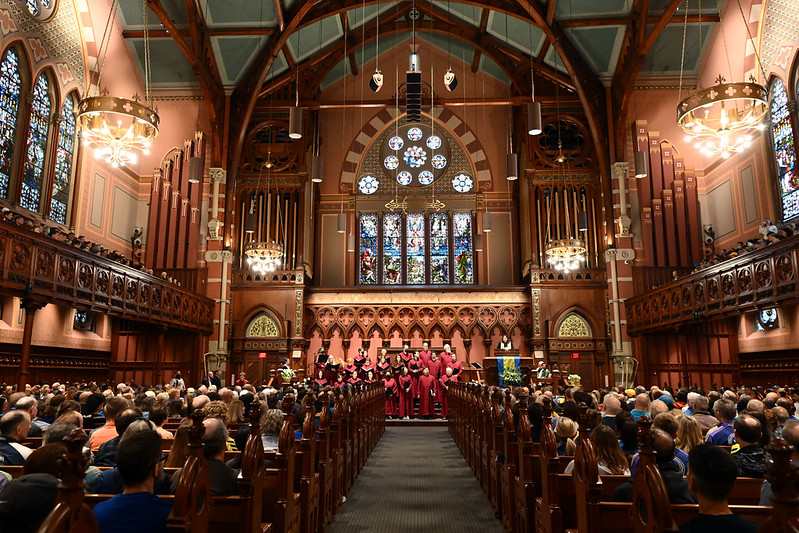Festival Worship - Third Sunday in Advent
Festival Worship - Third Sunday in Advent
Home By Another Road
The story of the Magi begins long before Bethlehem. The story of the Magi begins in the far reaches of the stars, and from 800 years before the birth of Jesus. It all began with the great king Nabonassar, ruler of the Babylonian empire.
To Nabonassar is the glory and the honor to have first begun work on the tablets recording the precise movements of the stars. Thus King Nabonassar began a project that would last centuries. Every single night, the Babylonian astronomers would observe the stars, chart their movements in the sky and note their appearances. Every night for over 800 years—these experts in the night sky would watch for when the stars arose and what their positions were in their sky. They would record their observations in minute detail on clay tablets, looking for the most miniscule changes and recording them for posterity. They carved their findings into wet clay so that their records would not rot away. Their task strained beyond the capabilities of their written language, and so they developed a new one. In order to make more efficient records, these astronomers used an ornate and complex code, the mathematical wing of the Cuneiform script. It was a code, as daunting as it was brilliant. Each tablet of records would be covered in thousands of tiny triangles, and to the astronomers initiated in this hidden language, each tablet held accurate star charts that spanned years. In just a day’s work and calculation, a Babylonian astronomer could look backward across ten lifetimes of observation. They alone of the ancients could perceive time and space together. They alone could watch centuries rise and fall.
And in those centuries, of all the information they amassed, they were most hungry to understand the movements of just a few special stars. Just a handful of stars out of ALL the lights in the heavens, a few that would change their position in the heavens. Most of the time they moved in lockstep with the stars, but sometimes they would race ahead of the others around them, sometimes they would move backward through the sky, sometimes standing dead still in the sky while all the heavens spin around them. To the Babylonian astronomers, they were the keys to understanding the heavens.
In later centuries they would be given names like Jupiter, Venus, Saturn, Mercury, Mars. But to the Babylonian astronomers they were called Marduk, Ishtar, Ninib, Nabu, Nergal.
They desired most of all to find and discover any logic or laws that stood behind the movement of these special stars. They looked for patterns in their centuries of records, and when they found patterns too complex to analyze, they developed new speculative mathematics. They accurately depicted the movement of Jupiter relative to the earth, charting a curvilinear line moving through abstract geometric space. With advanced mathematics and meticulous records, they could not only describe where these stars had been, but with precision could predict where these stars would appear and what their movements were going to be. Mark that especially, the Babylonian astronomers could predict future events years in advance.
But what drove them? To the Babylonians the stars were not things, like rocks, they were heavenly beings like angels, utterly obedient to divine will. The movements of the stars reflected the will of the gods, they were inextricably linked. If the gods were planning to leave the earth basically as is, then the stars would placidly hold their course in the sky. But if the gods were orchestrating great and mighty changes on the earth, they would be matched with great and mighty changes in the stars. This idea that great historical events will have strange astronomical phenomenon attached to them was hugely influential. This idea even still survives in our word catastrophe, literally an upheaval in the stars. The Babylonian astronomers could understand the movement of the stars, they had a roadmap to the events unfolding in the world, they would have a window into the plans of the gods.
The Babylonian astronomers were known throughout the ancient world as the foremost experts in the stars. In Israel, people called them Magi. Wise men or kings doesn’t not capture it. Magi were people who could do otherwise impossible things because they had access to hidden technical knowledge. Their tools were astronomical observation, specialized coding and decoding, abstract and theoretical mathematics. That is how the world’s foremost experts in astronomy came walking in to Jerusalem, asking where was the child who had been born king of the Jews. No word had been sent to them. They had learned about it by looking at the stars.
They saw something in the stars that others could not see. And the gospel story unfolds as if it quite obvious that the birth of Jesus should be attended by certain appearances in the stars. The gospel author is not troubled in the least that non-Jewish people from distant lands should be able to discern what God is up to in the world simply by looking at the stars and interpreting their movements.
It is only natural that these magi, these experts in hidden knowledge gleaned from the stars, should understand what God is doing in the world. Whatever we modern people may think of astrology and divination and omens and portents, the point of view revealed in the gospel is that these astronomers can understand what God is doing, because they can understand the natural world. This is the point of view revealed in the bible. I want you to hold off for a moment on judging this as superstition and just follow the train of reasoning.
For the bible, as for Christians in ancient times, there was not a distinction between what God was doing and what was going on in the natural world. It was a two-way street. God created the natural world, and the natural world revealed true things about God. Learning about the natural world was a legitimate and well established way to learn about God. It even has a name—natural theology.
It is old fashioned and unpopular these days, but natural theology is well attested in the bible. The apostle Paul, in his letter to the Romans, logically grounds its opening arguments in the idea that all people are capable of knowing God from examining the world that God created. Romans 1:
For what can be known about God is plain, because God has shown it to us. Ever since the creation of the world God’s eternal power and divine nature, invisible though they are, have been understood and seen through the world God has made. It is there as plain as day in Psalm 19: The heavens are telling the glory of God; and the dome of the stars proclaims God’s handiwork. Day to day they pour forth speech, and night to night they declare knowledge.
For the vast majority of Christian history, probing scientific understanding and deep faith have gone hand in hand. To know and understand the world deeply, is to know and understand something true of the divine. The Magi show us this. And some of the brightest lights of scientific inquiry have been either theologians as well in their own right, or deeply faithful people.
There is Francis Bacon who pioneered the modern scientific method and also published numerous works of theology and made his own translations of the psalms. There was Blaise Pascal, an influential mathematician and the Christian apologist influential enough that his most famous argument is known in a kind of shorthand as Pascal’s wager. There was Isaac Newton and Gottfried Leibniz, both men independently developed differential calculus and both were well known to be deeply pious men. Antoine Lavoisier the father of chemistry, Gregor Mendell the father of taxonomy, James Maxwell who first formulated electromagnetism, Hildegard of Bingen the mother of German medicinal botany, Virginia Apgar the mother of modern obstetrics, all of these people were enormously important scientists and deeply faithful people. This is no contradiction, the perspective of the bible and the weight of history agrees.
To peer beyond the basic appearances of nature, to seek after the laws that govern them, to devote an entire life to the search for what is true, this is holy work, it is in its own way a search for the face of God. The world needs new natural theologies, ones that are capable of understanding dark matter and dark energy, searching for echoes of creation itself when God separated the light from the darkness and declared it good. The world needs theologies of artificial intelligence, that looks on the stories of the Hebrew Bible not only as guidance for how to be children of the living God, but also searching for fresh meaning for what humanity becomes once we create what has never been before, for fresh sympathy and love for God the creator. And we must not be surprised when, like the magi visiting from afar with unbelievable news, fresh revelations from God arrive from most unlikely messengers. We should expect nothing less from the God who loves truth so much, that it should speak in all the world around us.







